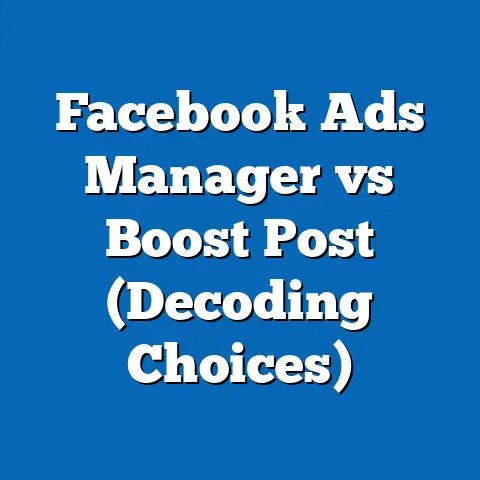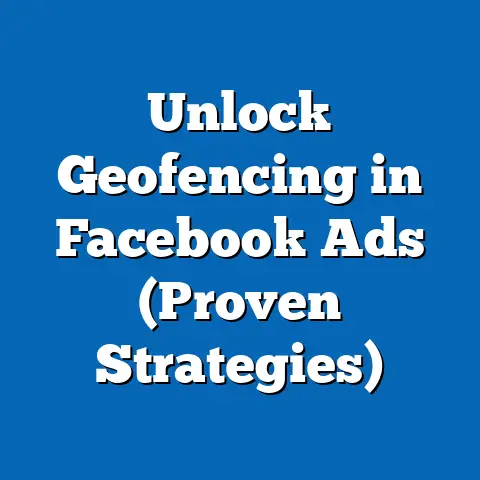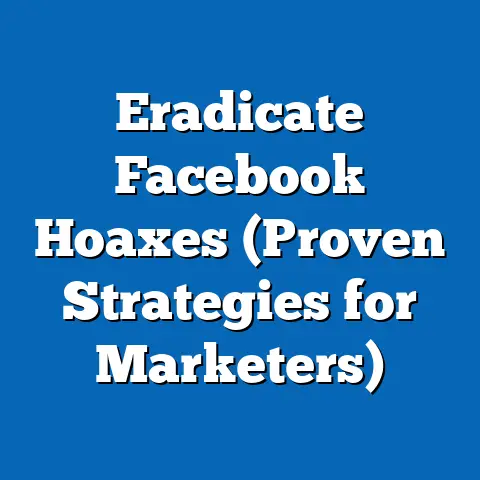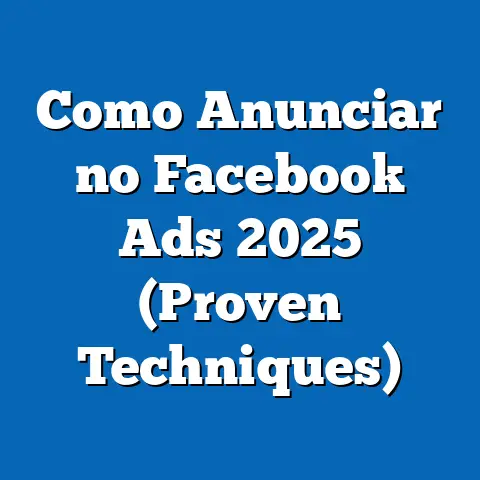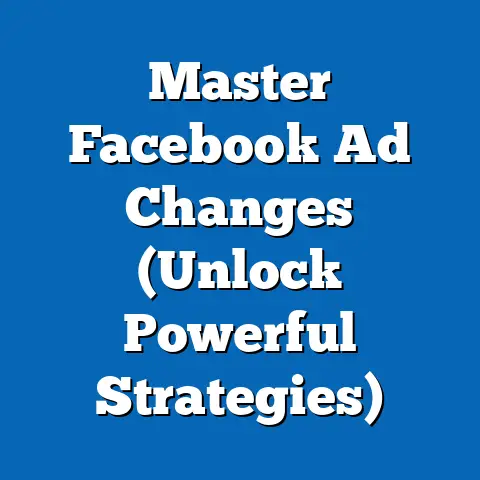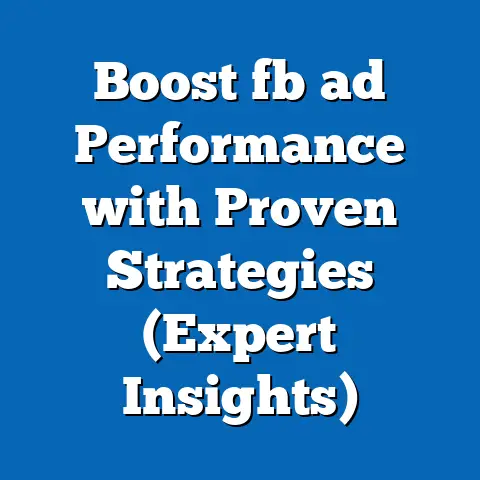Master Facebook Link Ad Dimensions (Ultimate Guide)
Did you know that Facebook generated over $84 billion in advertising revenue in 2020 alone? That’s a staggering number, and it underscores just how vital Facebook is for businesses looking to connect with their audience. As someone who’s spent years navigating the ever-evolving world of Facebook advertising, I can tell you that optimizing your ads is paramount. Today, I’m going to dive deep into one crucial aspect: mastering Facebook link ad dimensions. Getting this right can be the difference between an ad that converts and one that gets lost in the noise.
Understanding Facebook Link Ads
Facebook link ads are a specific type of ad format designed to drive traffic from Facebook to an external website. Unlike other ad types that focus on engagement within the platform itself (like boosting a post for more likes or shares), link ads are all about getting people to click and leave Facebook to visit your website, landing page, or online store.
What Makes Link Ads Different?
The key difference lies in their primary objective: driving off-site conversions. While other ad formats might aim for brand awareness or in-app actions, link ads are laser-focused on getting potential customers to your own digital real estate. I’ve found them particularly useful for:
- Generating leads: Directing users to a landing page with a signup form.
- Promoting products: Sending traffic to product pages on an e-commerce site.
- Sharing content: Driving readers to blog posts or articles on your website.
Why Are They Important?
In the crowded digital marketing landscape, link ads play a vital role in achieving tangible business objectives. They allow you to:
- Control the customer experience: Once a user clicks on your ad, you can guide them through a tailored journey on your website.
- Track conversions accurately: Use tools like Google Analytics to monitor user behavior after the click and measure the ROI of your ad campaigns.
- Build your own audience: Encourage users to subscribe to your email list or create an account on your website, allowing you to nurture them over time.
Takeaway: Facebook link ads are essential for businesses looking to drive targeted traffic to their websites and achieve measurable results.
The Importance of Ad Dimensions
Now, let’s talk about why ad dimensions are so crucial. I’ve seen firsthand how something as seemingly small as the wrong image size can tank an otherwise promising campaign.
How Dimensions Impact Performance
Think of your Facebook ad as a storefront window. If the window is dirty, cracked, or poorly lit, potential customers are less likely to step inside. Similarly, if your ad image is blurry, cropped awkwardly, or doesn’t fit properly within the ad space, it creates a negative first impression.
Here’s how improper dimensions can affect your ad performance:
- Reduced engagement: People are less likely to click on an ad that looks unprofessional or untrustworthy.
- Lower click-through rate (CTR): A poor visual presentation can significantly decrease the number of people who click on your ad.
- Increased ad costs: Facebook’s algorithm rewards high-quality ads with lower costs. If your ad has low engagement, you’ll likely end up paying more for each click or impression.
The Power of Visual Appeal
In today’s visually driven world, aesthetics matter more than ever. A well-designed ad can capture attention, convey your message effectively, and entice users to take action. On the other hand, a poorly designed ad can be easily overlooked or even damage your brand’s reputation.
I always tell my clients to invest in high-quality visuals. It’s not just about having a pretty picture; it’s about creating an ad that resonates with your target audience and makes them want to learn more.
Takeaway: Ad dimensions are a critical factor in determining the success of your Facebook link ads. Proper dimensions enhance visual appeal, improve user engagement, and ultimately drive better results.
Facebook’s ad guidelines can sometimes feel like a moving target, so it’s important to stay up-to-date with the latest recommendations. As of today, here’s a breakdown of the standard dimensions for Facebook link ads:Image Aspect Ratios
- 1:1 (Square): This aspect ratio is ideal for showcasing products or services in a clean, balanced format. I often use it for e-commerce ads or when I want to highlight a single, impactful image.
- 1.91:1 (Landscape): This is the most common aspect ratio for link ads, and it’s generally a safe bet for most campaigns. It provides a wide canvas that allows you to tell a story or showcase multiple elements.
Recommended Image Sizes
- 1200 x 628 pixels: This is the go-to size for link ads. It ensures that your image looks crisp and clear on both desktop and mobile devices.
- 1080 x 1080 pixels: If you’re using a 1:1 aspect ratio, this size is a good choice.
Video Dimensions
If you’re using video in your link ad, here are some key considerations:
- Recommended resolution: 1080 x 1080 pixels (for 1:1) or 1920 x 1080 pixels (for 16:9)
- Aspect ratio: 1:1, 16:9, 4:5 (vertical)
- Maximum file size: 4GB
Why Adhering to Dimensions Matters
Sticking to these dimensions is crucial for several reasons:
- Avoid cropping: Facebook’s algorithm may automatically crop your image if it doesn’t meet the required dimensions, potentially cutting off important elements.
- Prevent blurriness: Using a low-resolution image or one that’s too small can result in a blurry or pixelated ad, which looks unprofessional.
- Optimize for different placements: Facebook ads can appear in various placements (e.g., news feed, right column, Audience Network). Using the recommended dimensions ensures that your ad looks good in all placements.
Takeaway: Familiarize yourself with Facebook’s recommended ad dimensions and stick to them religiously. It’s a simple step that can have a big impact on your ad performance.
Best Practices for Designing Facebook Link Ads
Now that you know the technical specs, let’s talk about design. Creating visually appealing ads that adhere to Facebook’s guidelines is an art and a science. Here are some of my go-to tips:
Choosing the Right Images
- High-quality is key: Always use high-resolution images that are clear, crisp, and visually appealing. Avoid blurry or pixelated images at all costs.
- Relevance matters: Choose images that are relevant to your product, service, or offer. The image should immediately communicate what your ad is about.
- Show, don’t tell: Whenever possible, use images that showcase your product in action or demonstrate the benefits of your service.
- Consider your target audience: Think about what kind of images would resonate with your target audience. Are they drawn to bright, bold colors or more subtle, minimalist designs?
Crafting Compelling Headlines and Descriptions
- Keep it concise: Facebook ad copy should be short, sweet, and to the point. Get straight to the value proposition and avoid unnecessary fluff.
- Use strong verbs: Start your headline with a strong verb that grabs attention and encourages action (e.g., “Discover,” “Learn,” “Shop”).
- Highlight benefits: Focus on the benefits of your product or service, rather than just listing features. How will it make the user’s life better?
- Include a clear call to action (CTA): Tell users exactly what you want them to do (e.g., “Shop Now,” “Learn More,” “Sign Up”).
Branding Consistency
- Use brand colors: Incorporate your brand’s colors into your ad design to create a consistent look and feel.
- Choose appropriate fonts: Select fonts that are legible and align with your brand’s personality.
- Maintain a consistent tone: Use language and messaging that are consistent with your brand’s overall voice and tone.
Takeaway: Designing effective Facebook link ads requires a combination of technical expertise and creative flair. By following these best practices, you can create ads that capture attention, communicate your message effectively, and drive results.
Testing Ad Dimensions and Formats
You might be thinking, “Okay, I know the recommended dimensions, but how do I know what will work best for my audience?” That’s where A/B testing comes in.
The Importance of A/B Testing
A/B testing involves creating multiple versions of your ad with slight variations (e.g., different image dimensions, headlines, or CTAs) and then running them simultaneously to see which performs best. It’s a data-driven way to optimize your ads and ensure that you’re getting the most bang for your buck.
I’ve seen clients double or even triple their CTR simply by testing different ad variations. It’s a game-changer.
Tools and Methods for Testing
Facebook Ads Manager has built-in A/B testing capabilities that make it easy to create and track different ad variations. Here’s how it works:
- Create a new campaign: Choose your objective (e.g., traffic, conversions).
- Set up your ad set: Define your target audience, budget, and schedule.
- Create your ad: Design your first ad variation.
- Duplicate your ad: Create a copy of your ad and make a small change (e.g., use a different image dimension).
- Run the test: Let Facebook’s algorithm distribute traffic evenly between the two ads and track their performance.
Analyzing Ad Performance
Keep a close eye on key metrics like:
- Click-through rate (CTR): The percentage of people who saw your ad and clicked on it.
- Cost per click (CPC): The average amount you pay each time someone clicks on your ad.
- Conversion rate: The percentage of people who clicked on your ad and then completed a desired action (e.g., made a purchase, filled out a form).
Takeaway: A/B testing is essential for optimizing your Facebook link ads. By testing different dimensions, formats, and messaging, you can identify what resonates with your target audience and improve your ad performance.
Common Mistakes to Avoid
Even experienced marketers sometimes fall into common traps when creating Facebook link ads. Here are some pitfalls to watch out for:
Tools and Resources for Creating Facebook Link Ads
Creating stunning Facebook link ads doesn’t have to be a headache. There are plenty of fantastic tools and resources out there to help you get the job done:
Graphic Design Tools
- Canva: This user-friendly tool is perfect for creating eye-catching graphics, even if you’re not a professional designer. It offers a wide range of templates and design elements specifically tailored for Facebook ads.
- Adobe Spark: Another great option for creating professional-looking graphics and videos. It’s part of the Adobe Creative Cloud suite, so it integrates seamlessly with other Adobe products.
- PicMonkey: A versatile online photo editor with a variety of tools and effects for enhancing your images.
Staying Updated
- Facebook Ads Help Center: The official resource for all things Facebook advertising. It’s a must-read for staying up-to-date with the latest guidelines, policies, and best practices.
- Facebook Business Blog: Offers insights, tips, and case studies from Facebook’s team of experts.
- Industry blogs and forums: Stay informed about the latest trends and strategies by following reputable digital marketing blogs and participating in online forums.
Takeaway: Don’t reinvent the wheel. Take advantage of the many tools and resources available to help you create effective Facebook link ads.
Conclusion
Mastering Facebook link ad dimensions is a fundamental aspect of successful advertising on the platform. By understanding the importance of ad dimensions, adhering to Facebook’s guidelines, and implementing best practices for design and testing, you can create ads that capture attention, drive traffic, and achieve your business objectives.
I’ve seen countless businesses transform their Facebook advertising results by focusing on these details. It’s not just about having a great product or service; it’s about presenting it in the best possible light.
So, take the time to learn the ropes, experiment with different dimensions and formats, and continuously optimize your ads based on performance data. The rewards will be well worth the effort.
Call to Action
Now, I’d love to hear from you! What are your biggest challenges when it comes to creating Facebook link ads? Have you had any success stories with dimension testing? Share your experiences and questions in the comments below, and let’s continue the conversation. And if you need further assistance in mastering your Facebook advertising strategies, don’t hesitate to reach out. I’m here to help you succeed!

